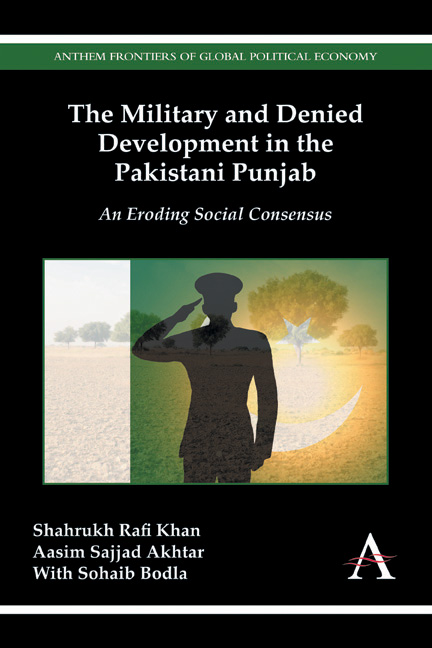Book contents
- Frontmatter
- Dedication
- CONTENTS
- Acknowledgments
- Abbreviations
- Preface
- Chapter One The Military and Economic Development in Pakistan
- Chapter Two Punjab's State–Society Consensus on the Military's Dominance and Economic Role
- Chapter Three Research Design, Method, Institutional Issues and Scope of the Military's Land Acquisitions
- Chapter Four The Military's Agrarian Land Acquisitions: High Handedness and Social Resentment
- Chapter Five From Social Resentment to Social Resistance
- Chapter Six Bahria Town: A Military-Related Real Estate Venture
- Chapter Seven The Military as Landlord in the Pakistani Punjab: Case Study of the Okara Farms
- Chapter Eight Guardians No More? The Breakdown of the Consensus
- Glossary
- Index
Chapter Three - Research Design, Method, Institutional Issues and Scope of the Military's Land Acquisitions
Published online by Cambridge University Press: 05 December 2014
- Frontmatter
- Dedication
- CONTENTS
- Acknowledgments
- Abbreviations
- Preface
- Chapter One The Military and Economic Development in Pakistan
- Chapter Two Punjab's State–Society Consensus on the Military's Dominance and Economic Role
- Chapter Three Research Design, Method, Institutional Issues and Scope of the Military's Land Acquisitions
- Chapter Four The Military's Agrarian Land Acquisitions: High Handedness and Social Resentment
- Chapter Five From Social Resentment to Social Resistance
- Chapter Six Bahria Town: A Military-Related Real Estate Venture
- Chapter Seven The Military as Landlord in the Pakistani Punjab: Case Study of the Okara Farms
- Chapter Eight Guardians No More? The Breakdown of the Consensus
- Glossary
- Index
Summary
Introduction
There are three kinds of military agrarian land acquisitions in the Punjab: individual border-land allocations, other individual welfare-land allocations, and collective land allocations such as for a stud farm. As documented in the previous chapter, the practice of allotting land to military personnel in irrigated districts of Punjab has a long history. With the inception of the new state, this practice continued, with General Ayub Khan's regime initiating allotment schemes on the eastern border with India. This process intensified with each new military regime and with General Musharraf they reached a new high in the form of nonborder allocations in districts in the Siraiki belt such as Bahawalpur, Layyah and Bhakkar. Even collective land allocations are often reduced to individual allocations, as indicated in chapters 4 and 5. Unless otherwise specified, the two broad categories we work with in this, and the next two, chapters are border and nonborder allocations. Allocations vary positively across the military hierarchy by rank.
The military's agrarian interventions are in both the Punjab and Sindh provinces. We focused on the Punjab because it is here that a distinct state– society consensus has been forged (see chapter 2). In the rest of this chapter, we explain our evolving research design and method, and outline the institutional issues pertinent to our research including the conceptualization of the border allotment scheme, the allocation process, legal issues including those pertaining to civil-military conflict and border Rangers and police jurisdiction issues. We follow with information on the scope of the nonborder allocations and end with a preview of the field research based chapters that follow.
An Evolving Research Design and Method
We originally intended to focus only on the border allocation scheme and to select a stratified random sample. The border allotments are made in a five-mile belt all along the Indian–Pakistan border. In Punjab, this starts from Sialkot district in the north and ends with Rahim Yar Khan district to the south. The interim districts are Narowal, Sheikhupura, Lahore, Kasur, Okara, Bahawalnagar and Bahawalpur. Not all land in this five-mile belt has been allocated and some of the land originally owned in this belt is under civilian ownership.
- Type
- Chapter
- Information
- The Military and Denied Development in the Pakistani PunjabAn Eroding Social Consensus, pp. 43 - 64Publisher: Anthem PressPrint publication year: 2014

